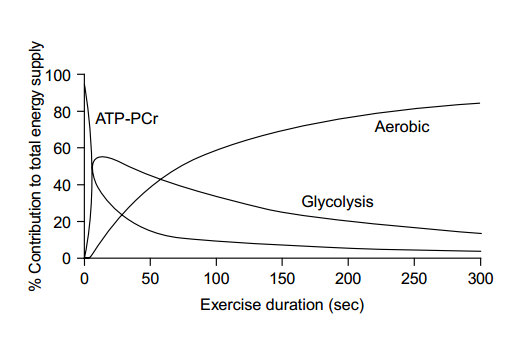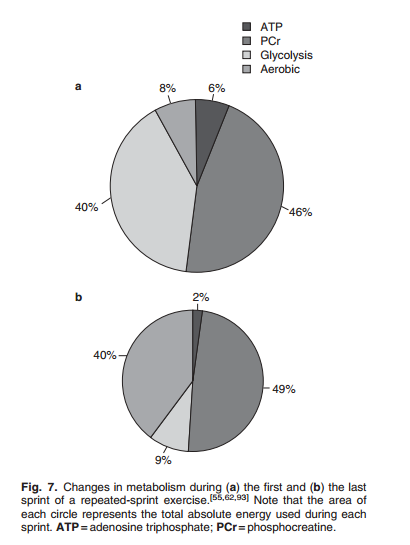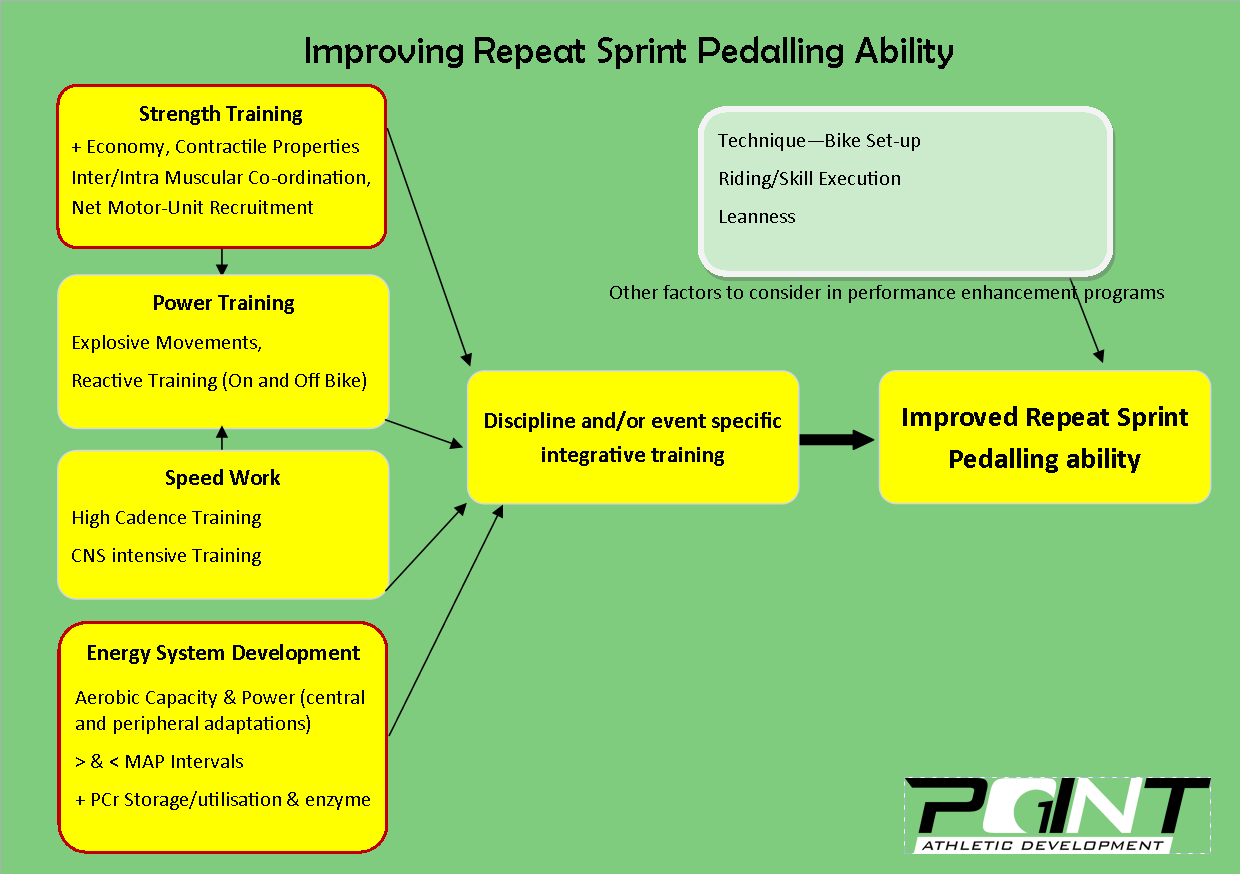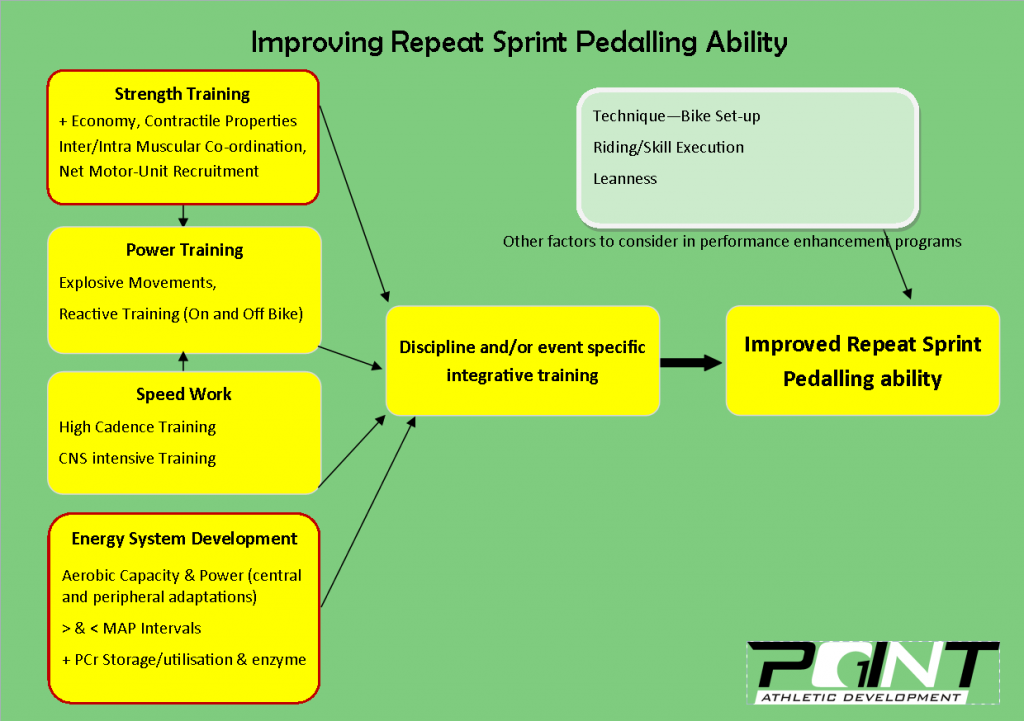How often does one make full revolutions of the cranks in a DH race and during practice? Well that depends; course type, terrain, climatic and environmental conditions, gear ratios etc…
What is a certainty though is that pedaling during DH racing is intermittent i.e. “occurring at irregular intervals; not continuous or steady”. While we ride DH on a bicycle, two wheels, cranks, chain etc… unlike our roadie or XC cousins, quite often the main means of locomotion for the DH athlete/rider isn’t application of force on the pedals but gravity! Having said that tough, what is also certain is that pedaling can be a determinant of performance and results.
So it goes without saying that understanding the energetics (how energy is supplied) for these intermittent repeat sprint bouts is quite important when looking to prepare yourself to meet the varied physical demands of DH. Interestingly repeat sprint ability is something that in the last decade has been study a great deal in the laboratory by many well respected sports scientists. Even more interesting is that many of the Repeat sprint Ability (RSA) testing protocols used in these studies mimic the demands of DH specific pedaling dynamics closer than they do the sports they are primarily testing/researching for (field and court sports, soccer, basketball, tennis, ARF, hurling etc…).
Many of the studies used a 6 sec “MAX” sprint interspersed by 24 to 30 sec of stationary/passive recovery. So if we look at a power metre graph from a fairly typical DH run we can see the similarities.

Similarities there may be but on the other hand there are some key differences and this is where we will start our wee journey into hopefully understanding the Repeat Sprint Pedaling Demands of DH a little bit better and then go on to talk about the key areas we need to train to improve our RSPA – Repeat Sprint-Pedaling Ability!
What are you looking for?
As a DHer you’re looking for two key things to ensure optimal pedaling performance. 1)Achieving a high peak power output, 2)minimising the reduction in this peak power output over repeated sprints. In other words reducing your fatigueability over many repeat efforts on the pedals in one run. In short this IS Repeat Sprint Pedaling Ability.
The exact causes of fatigue during repeat sprints is the topic of hot debate and much research but having a clear grasp of the most likely and/or proven factors in RS fatigue is the first step in understanding how to train effectively to increase your potential to create repeat power!
Back to Basics
Before we get to a point where we can understand the factors that create fatigue and limit RSPA you’ve got to understand the relative contributions of each one of our three energy systems to “all-out” riding during a DH run.
The 3 energy systems are distinct but closely integrated, they operate together in a sequential but overlapping manner to supply working muscle with the energy it demands. The energy systems are split into 2 categories. Aerobic (with oxygen) and Anaerobic (without oxygen). The Anaerobic systems are subdivided into ATP-PCr and Anaerobic Glycolytic (the infamous anaerobic lactic system).
The ATP – PCr system is the most direct supplier of energy to muscle. As a tiny amount of stored ATP (our energy currency) exists in skeletal muscle along side stores of the high energy phosphate Phosphocreatine (PCr), between the instant utilisation of ATP and the very fast breakdown of PCr large amounts of energy can be supplied to working muscle very quickly for a duration of up to 8 seconds give or take! This is why Sprint 1 of a DH race is the most powerful. Maximum stores of PCr, minimum fatigue, maximum neural drive!
The second anaerobic system is the glycolytic system, this is simply the break down of stored carbohydrate (glycogen) in the muscles with no oxygen. This is a fast supplier of energy as the reactions take place in the site where movement will be created, but it has it’s limitations as it creates many by-products that need to be shuttled away from the working muscles for movement to continue. The “lactic” system can provide energy for up to 75 secs but really beyond the 35 sec mark our next energy system, the Aerobic system, really kicks in.
Finally the aerobic system breaks down stores of fat and carbohydrate to produce ATP (our energy currency), this happens in the muscle but not directly at thesite of movement, so it’s not quite as “fast”. But if we are correctly warmed up then aerobic metabolism produces a large percentage of our energy for any “all-out” activity beyond the 75sec mark! And remember the average DH World Cup run is 225 to 275sec in duration.

How it fits into DH Specific RSPA?
Right so now that we have the dull stuff out of the way let’s get down to business. AS we could see in the power trace graph further up DH often requires a hard initial sprint out of the start gate, followed by repeat “all-out” efforts on the pedals at irregular intervals. You can have anything from 3-5 secs right up to minutes between pedaling efforts (ala Val di Sole). Usually though it’s pedaling bouts of 3-6 secs with gaps between of 10 – 25secs.
So most of the very good research out there points to 2 things, firstly the initial sprint performance is very important and that this initial sprint of 3-6 sec is fueled mainly by the ATP-PCr system. With gaps of 10-25sec between repeat efforts on the pedals it is again the ATP-PCr system that fuels the efforts but onl if your AEROBIC system is “fit” enough to replenishes your PCr stores, as it is solely the Aerobic system that replenishes your stocks of PCr! Finally once you get out to the 225 sec + mark in time it looks like the fittest athletes with the best RSPA rely heavily on the aerobic system to fuel these final sprints with the glycolytic system contributing only ¬8%!
Pie chart below showing what I’m talking about from the great review on the subject by Girard et al 2011 Sports Med 2011; 41 (8): 673-694
So things seem clear for now…right? The above test protocol was 10 X 6 sec sprints with 30 sec recovery between them, so not to dissimilar to the demands of DH pedaling….right? Well maybe it’s not that simple! The 30 sec recovery between the 6 sec effort sin the above study was total rest, stationary chill-out until your next 6 sec bout and that’s where the similarities with DH end!
Because as we all know between sprints on your DH bike there’s usually a whole lot happening, riding! Yep the main bulk of our performance and most certainly the main determinant of performance is actually riding your bike and riding it FAST. So how does that effect your RSPA? Well it’s something that has never been directly studied, but as a coach for many DH athletes it’s something I can certainly make some educated assumptions about!
What do we do?
Well basically you hang off the steed at a million clicks and try hit your lines? Well not quite but the demands of DH are pretty varied and as such are pretty complete. The basic goal is choosing the best, fastest line from A to B and executing the required techniques at the required time to make your lines and carry the required speed to have the fastest time! Simple!
But the energy demanded by riding as fast as possible from A to B is substantial. Especially when the terrain is rough, steep, fast and gnarly. The mix of isometric, eccentric and concentric muscular contractions, the fine and gross motor skills that executing a huge range of techniques requires is hugely energy hungry. Maintaining posture, exploding off jumps, hitting and skipping over huge holes, railing berms, climbing off-cambers and shredding turns all require energy to be produced by all 3 energy systems in unison by in time and intensity dependent amounts.
How riding affects pedaling?
No need to complicate the discussion really. The harder you ride the more intramuscular energy stores you’ll burn and the less likely you are to have re-synthesized even partial amounts of PCr for pedaling after the first sprint. But, the more skillful you are, the better your technique is and the less energy you expend while riding at optimal pace the more likely it is that you’ll still have adequate stores of ATP, PCr and muscle glycogen to fuel very rapid metabolic reactions to power short sprint efforts. Likewise as the muscles we use to maintain riding posture and execute techniques are not used in exactly the same way and with the same inter and intra-muscular co-ordination as during pedaling then we can assume that the more aerobically fit you are the more likely you are to re-synthesize stores of PCr that could be used for explosive pedaling actions.
It’s an interesting topic and something that warrants good research, we know that steep natural tracks are more physically demanding in their riding induced loads (Hurst, Swaern et.al 2013) than “bike-park” style tracks, but often steep natural tracks require little pedaling and certainly show few of the hallmarks of the demands of RSPA.
Course duration too will have a large effect on inter-relationship of the three energy systems and how your body chooses to supply the required metabolic energy to make the muscles contract in sequence for pedaling.
Alot of these “issues” presented have some pretty common sense, evidence backed answers. As we’ll see below.
How to ensure “RSPA” performance?
How to train for supreme RSPA performance? First identify the limiting factors, understand how to improve them then integrate the training.
One of my favourite quotes is “you can’t maintain what you don’t have”, basically looking to improve your sprint capacity or repeat sprint ability is pretty worthless if you can’t sprint in the first place. So training the mechanical factors like strength then power, intra muscular co-ordination, neural drive, fibre type, motor-unit recruitment etc… is key! These can be trained in the gym and on the bike. With the gym offering many benefits the bike does not.
Once mechanical power production is developed it needs to be supported by the metabolic processes, the energy systems and other factors such as enzyme activation and energy stores.
Training the aerobic system to it’s optimal state so re-synthesis of PCr is improved (Bishop, Girard et.al 2011), one study carried out in Norway ( Balsom et.al; Acta Physiol Scand 1994) showed large (11%+) improvements in RSA (again 10 X 6sec sprints) when participants where administered EPO, thus improving the oxygen carrying capacity of their blood and subsequently aerobic “fitness”. Like-wise similar RSA tests where participants have actively restricted blood flow (ischemia) to the legs their was a marked reduction in RSA performance over 10 sprints due to the inability of the aerobic system to re-synthesis PCr stores and actively provide energy for muscular contraction in it’s own right.
Starting training session in a fully fueled state so training “impulse” and signaling for a sprint session is at it’s highest.
Training to resist, buffer or better deal with metabolic by-products of high intensity exercise created by the Anaerobic Glycolytic system should also be considered, especially for mixed tracks that require a variety of riding styles or techniques and pedaling. The inorganic phosphates and general acidosis created by anaerobic glycolytic metabolism play havoc within muscle tissue and reduce the “excitability” of the muscles, reducing their contractile function and intra-muscular co-ordination, one of the main reasons why increases in fatigue causes crashes, falls, poor performance or that feeling of being a complete tool on the bike!
Improving your technique and skill on the bike will possibly lead to less energy expended for the same speed A to B and as such more potential energy available to fuel sprint pedaling performances and possibly more window for your aerobic system to re-synthesis PCr in the “pedaling muscles”.
Integrating any training you do to actually “work” on your race bike under conditions characteristic of the sport is also a crucial area often over-looked by many.
The importance of training the anaerobic glycolytic pathways of energy production for pedaling performance for DH is highly debatable. There certainly are specific courses (PMB, Canberra) where this type of training could be beneficial but much of the anaerobic fueled demands in DH are not pedaling induced, but riding induced.
Wrap Up
Much of the data, studies and evidence presented here comes from repeat pedaling tests, but designed by scientist looking into the demands of field and court based sports not MTB. So as such common-sense and experience based critical analysis should be applied to everything you read.
Are the pedaling bouts in DH repeat, sporadic and intermittent in nature? YES. Is each course equal? No. Do the demands on energy supply and change with the activity profile and riding dynamics of each individual course…absolutely! What does all that mean for the DHer looking to improve their performance on the pedals? Get strong, be fluid on the bike, relax, train all 3 energy systems but not all the time nor in equal amounts.
Every one has their own strengths and weaknesses. But with the huge variety in courses, pedaling demands and the ever changing environment (weather, altitude, courses etc..) you face as a DHer having a well tuned aerobic system and a big strength foundation will serve you very well. Couple that with good mobility, flexibility, adequate nutrition and characteristic training and you’ll be well on your way to pedaling well on your DH bike.
Below I’ve included a chart covering the main ways you can improve your RSPA. adapted from the fantastic work of Mladen Jovanovic @ www.complementarytraining.com
We could talk training methodology, influence of hostile environments (altitude) on RSPA, best practice during different stages of development, pedal type, tyre type, wind resistance etc… for days on end, so feel free to ask questions or create some discussion in the comment section.
Just always remember performance and fatigue are multi-factoral, so your training should reflect that. But you can’t train all factors all the time. So a good coach or clever head to plan your progressions in training is needed!
This is part 1 in a two part series, next up will be the pedaling demands of Enduro racing and how best to train for them!
Chris


